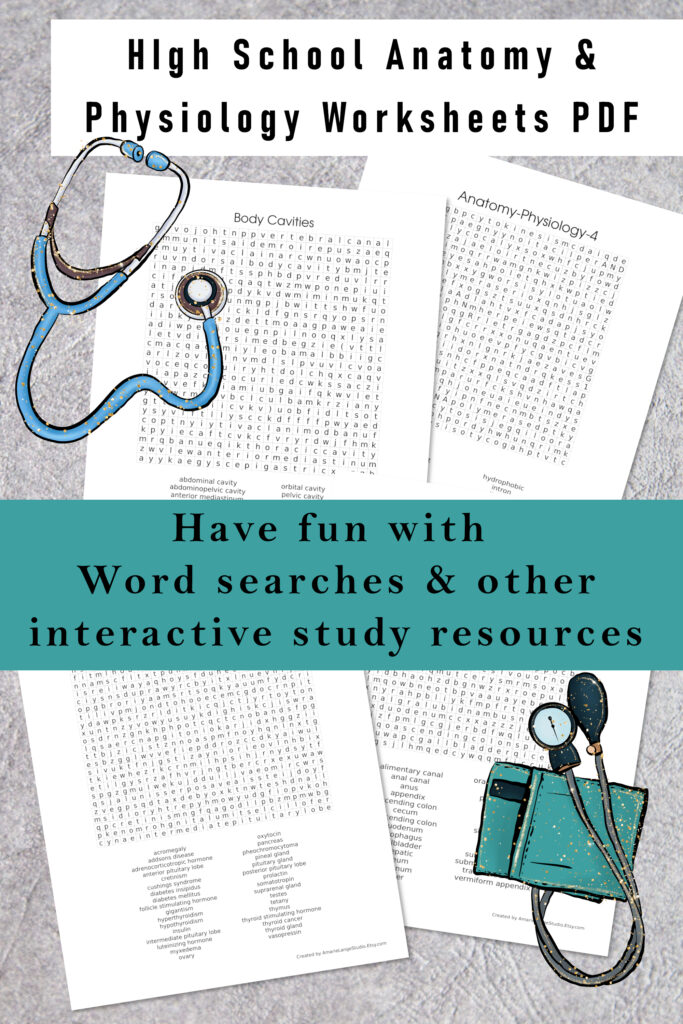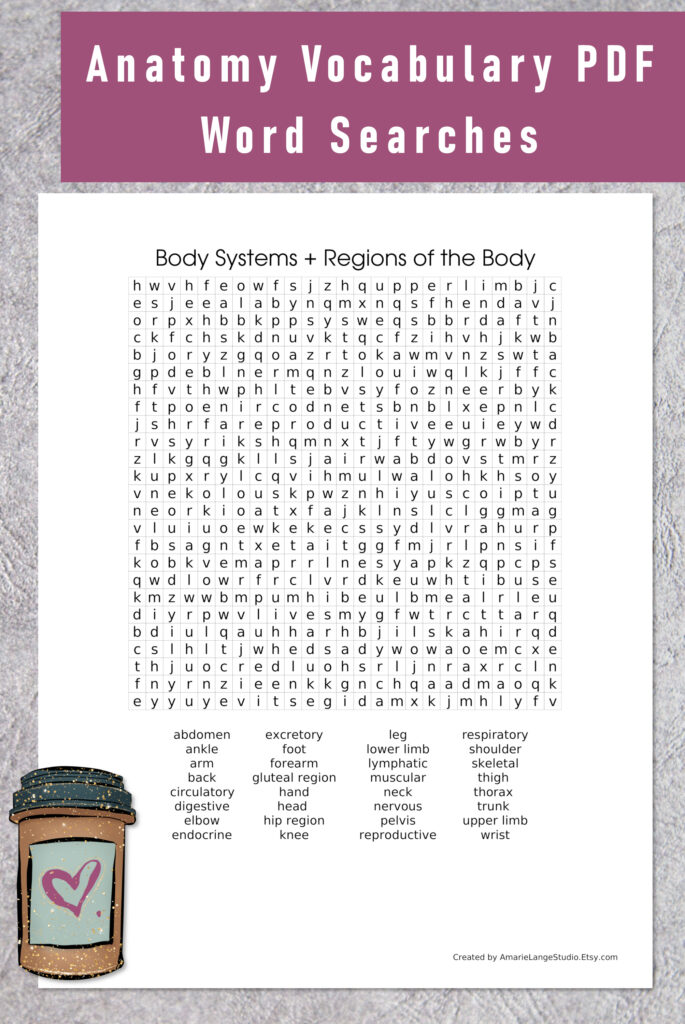Are you a high school student studying anatomy and physiology? Are you hoping to go into a medical field some day? Then you’re learning how challenging it can be to understand the complex concepts and systems of the human body. I helped my daughter, who is now a nurse, study A&P medical terminology when she was in her pre-nursing courses. We discovered one of the best ways to reinforce her learning and test her knowledge was through the use of practical worksheets and flashcards. High school anatomy and physiology worksheets PDF s and other interactive resources – including wordsearch puzzles – are designed to help you practice and review some of the material covered in your class.
So…I decided I would create a set of word search printables that could help other future health career students study their anatomy terms.
I love making useful printables and so it was important to me to design each anatomy and physiology vocabulary PDF word search individually. My daughter helped organize the vocabulary. In all, there are 31 puzzles covering a wide range of topics, from the basic structures of the body to the intricate workings of the nervous and endocrine systems. These are advanced word searches, which means you will find the answers forwards and backwards, horizontally, vertically and diagonally. By completing these word searches, you can identify areas where you need more practice and gain a deeper understanding of the entire subject matter.
Whether you’re preparing for a test or simply want to reinforce your learning, these anatomy and physiology wordsearches can be an invaluable tool. They allow you to test your knowledge, find out the areas where you need more practice, and get the knowledge of the complex systems of the human body deeper into your brain. Plus using these wordsearches over and over again is a fun way to practice anatomy and physiology words a-z! And while they will work with high school students just getting starting in their medical studies, these helpful word searches will be a great help for anyone aiming for a medical career.
“Be proud of yourself for choosing a challenging course and working hard to achieve your goals. Step by step, you can do this.”
Engaging High School Students
Let’s face it: it’s hard to learn all of those lists of anatomy terms. As a high schooler, this may be one of the tougher classes you’ve taken. Getting good grades in A&P I and II will give you a solid foundation for your future medical training. These are complex concepts that you’ll need to not only retain, but thoroughly understand. Here are a few tips to help you stay engaged as a high school student:
Use Interactive Activities
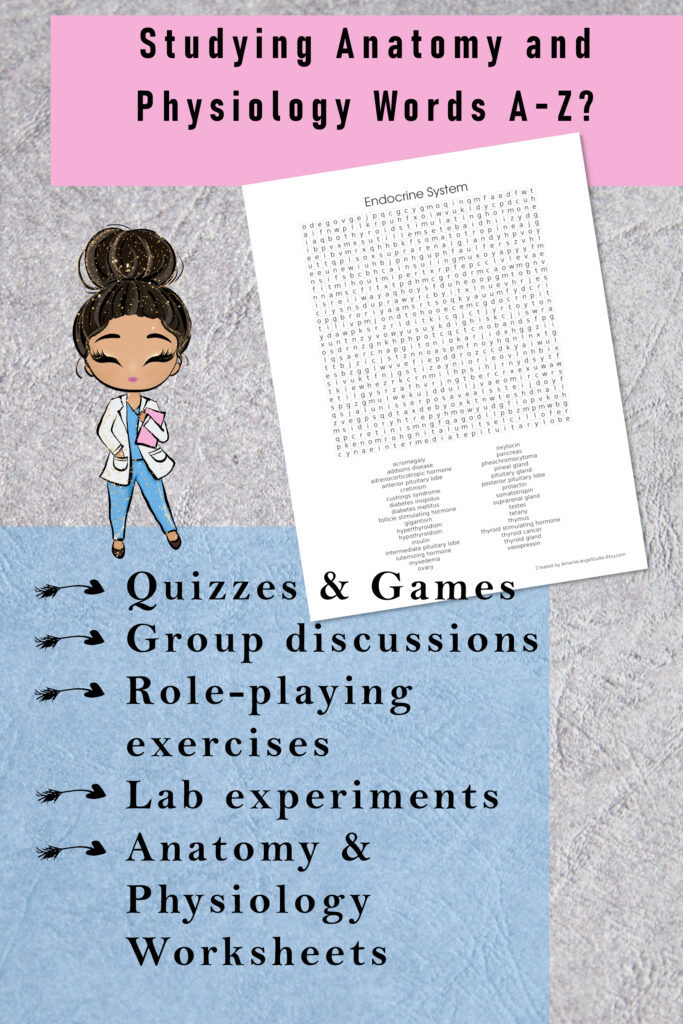
Interactive activities are a great way to engage high school students (or anyone else) in anatomy and physiology. These activities can include:
- Group discussions
- Role-playing exercises
- Lab experiments
- Quizzes and games
- Anatomy and physiology worksheets
Honestly, combining these ideas works, too:
- Have study group discussions about the lab days
- Find as many anatomy vocabulary PDF quizzes and games as you can. Use the ones I made or find others online.
- Let your younger siblings quiz you (those of us who aren’t taking medical courses will really get pronunciations wrong!).
- When using the word searches, spell the terms out loud without looking after you find them.
- Color code the vocabularies in different groupings.
- Do these word searches (or other worksheets) upside down or from the side. This forces your brain to get good at recognizing these complex words.
By using interactive activities, you can make learning fun and help yourself retain information more effectively.
Use Real-Life Examples
As a high school student, you are more likely to be engaged in anatomy and physiology if you can see the relevance of what you’re learning to your everyday life. So try and use as many real-life examples in your self-teaching as you can. This can help any student connect what they are learning to the world around them. For example, try discussing how the digestive system works when you eat your favorite foods or how the respiratory system is affected by air pollution.
Encourage Questions about Anatomy & Physiology
Encouraging questions is a smart way to keep your engagement high as a high school student learning anatomy and physiology. Keep a running list of questions and try to answer a few after each study session. As a student, this can clarify your understanding of complex concepts and help you engage in critical thinking.
It goes without saying that to encourage good questions you’ll need:
- To create a safe and supportive classroom environment, whether this is at home or in a more formal setting
- Opportunities to ask questions either during class or at a scheduled time outside of class.
- Helping and encouraging students with the resources to research questions after class
My daughter was barely out of high school when she went through her A&P classes and these tips kept her engaged and learning these complex concepts more effectively. Maybe they can help you, too.
Understanding Human Anatomy
As a high school student studying anatomy and physiology, it is important to have a basic understanding of the human body and its different systems. Human anatomy is the study of the structure and function of the human body, including the organs, muscles, bones, and tissues. Since we’re not teaching in this post, but merely showing some possible study tips, we’re not going to discuss all the bones in the human body. But to help you see the possibilities of using medical terminology worksheets, here’s one on the axillary skeletal system of the human skeleton you can download right now.
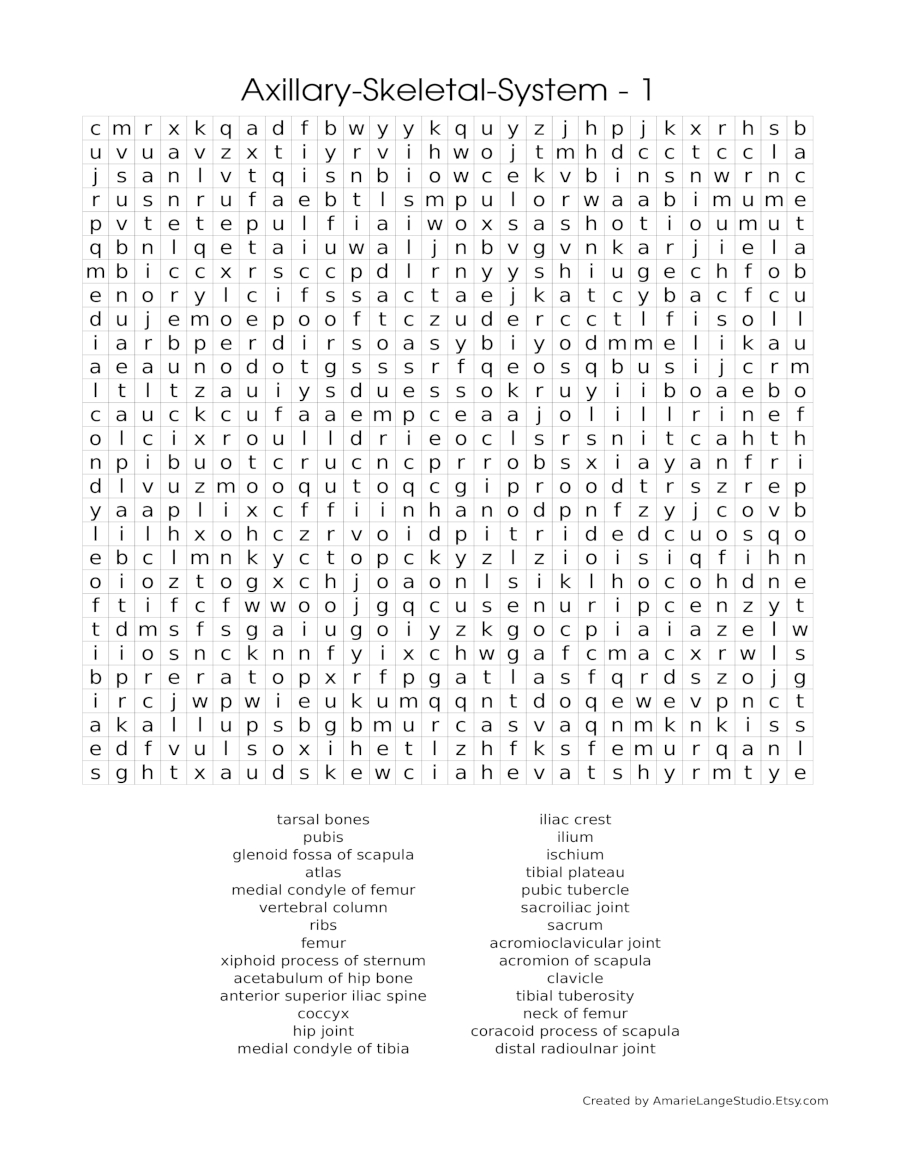
The human body is made up of several organ systems that work together to keep the body functioning properly. Systems such as the circulatory system, respiratory system, digestive system, nervous system, and endocrine system, among others. Each system has a specific function and is made up of different organs and tissues.
Understanding the different systems of the body and how they work together is essential for understanding human anatomy and physiology. By studying the structure and function of the human body, you can gain a deeper appreciation for the complexity and beauty of the human form.
Physiology Worksheets
Of course, anatomy vocabulary is just the beginning. Physiology worksheets are an excellent way to help you learn more about the human body and how it works. These worksheets cover a wide range of topics, including the circulatory system, the respiratory system, the nervous system, and more. They will build on your anatomy knowledge. These worksheets are designed to help you understand the different functions of each system and how they work together to keep your body healthy. One of the best things about physiology worksheets is that many are available for free online.
There are a lot of websites that offer free printable worksheets in PDF format. This means that you can easily download and print out as many worksheets as you need to help you study and learn more. Here is a great bundle of physiology worksheets to start with.
Physiology worksheets are also a great tool for your teachers. These worksheets can be used to supplement high school classroom lessons and help students better understand the material. Teachers can use these worksheets to create quizzes, tests, and other assessments to evaluate student understanding.
“Use all the resources you have at your disposal. Add some fun to your studying with word searches and other word puzzles.”
Anatomy Curriculum
Are you just beginning a high school anatomy and physiology course? If so, the structure and function of the human body will be your main focus. The anatomy curriculum will cover a wide range of topics, including the skeletal, muscular, circulatory, respiratory, digestive, and nervous systems, as pointed out above.
High School Anatomy & Physiology Course Overview
The anatomy curriculum will be divided into several units, each focusing on a different system of the body. The lesson plans will go over the various organs and tissues that make up each system, as well as their functions and interactions with other systems. You will also study the different types of cells that make up the human body, as well as their roles in maintaining homeostasis. Throughout the course, you will have various assignments, including quizzes, tests, and projects. To do well in these high school anatomy and physiology classes you will want to plan your study time carefully.
Once you decide how much time you’ll need to commit to studying each week, the next question is what will you do with that study time? This post focuses on how you can use printable study worksheets to your best advantage in studying A&P medical terminology.
Body Systems
One of the most important aspects of anatomy and physiology is understanding the different body systems and how they work together to keep you healthy. There are many body systems to explore, including the nervous system, digestive system, muscular system, reproductive system, integumentary system, respiratory system, immune system, skeletal system and circulatory system. You’ll probably cover topics like homeostatic imbalance, too. There are a lot of helpful worksheets, posters and such available online for this. Some are free, others require payment.
Here is a very basic worksheet to start with. Here’s another more complex Power Point Lesson on the Integumentary System.
Medical Terminology
As you delve into the world of anatomy and physiology, you will quickly realize that medical terminology is a crucial part of understanding the human body. Medical terminology is a specialized language that you will need to learn if you want to progress in the medical field. It is important to learn medical terminology because it allows you to communicate effectively with your peers and understand medical documents.
Medical terminology is made up of many different parts, including prefixes, suffixes, and root words. These parts are combined to create words that describe specific medical conditions, procedures, and treatments. For example, the word “cardiovascular” is made up of the prefix “cardio-” which means heart, and the word “vascular” which means blood vessels. Together, these words describe the system that is responsible for pumping blood throughout the body.
Word searches are great for getting a handle on how a medical term is used. By going over anatomy word searches again and again you teach your brain how to quickly find those root words, prefixes and suffixes.
Also within the same wordsearch your brain can see how the same prefixes and suffixes are used in different medical terms as building blocks in other medical terminology.
The same thing is true of directional terms in medical terminology. Directional terms are used to describe the position of one body part in relation to another. For example, “anterior” means towards the front of the body, while “posterior” means towards the back of the body. Understanding directional terms is essential when studying anatomy and physiology because it allows you to accurately describe the location of different organs and structures in the body.
Here is a simple test of your directional terms knowledge.
The more practice you can get using medical language, the quicker it will become second nature for you.
Study Guide and Resources
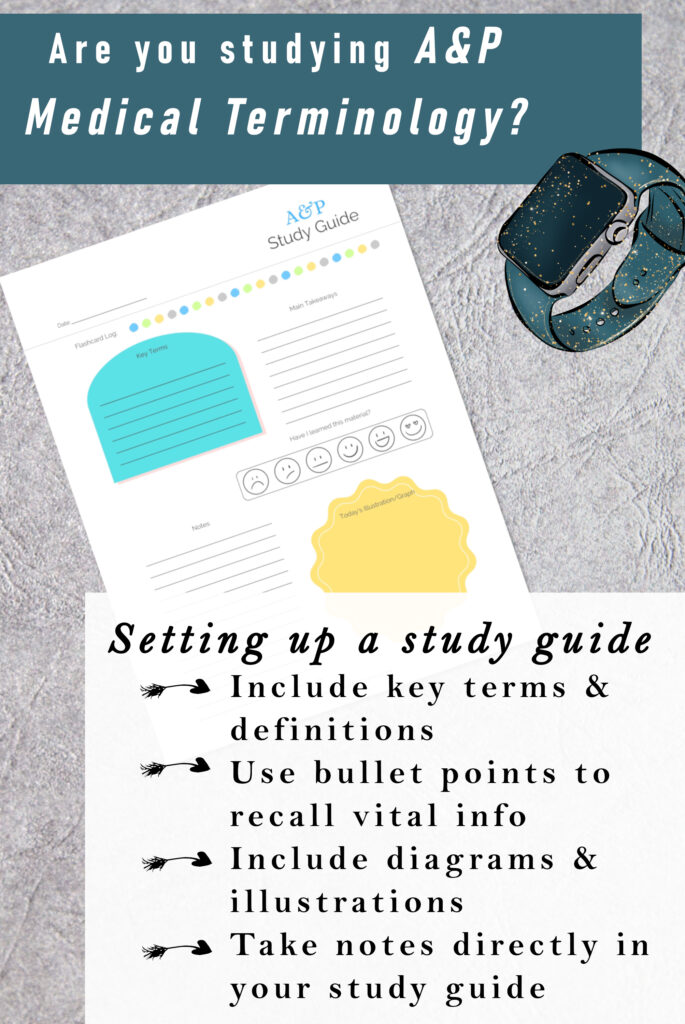
When it comes to studying anatomy and physiology in high school, having a good study guide + resources can make all the difference. Here are some great links and printables that can help you succeed in your studies:
“Get smart about studying. Try different methods. Discover your learning style. Teach what you learn to others, even if it’s just to the family dog.”
Using a Study Guide
A study guide is a great tool to help you organize and review the material you learn in class. It can also help you prepare for exams. Check out these tips for creating an effective study guide:
- Here’s a free editable study guide. Once you try it out for your daily or weekly schedule you can change it depending on your needs.
- Use headings and subheadings to organize the material. Include key terms and definitions. Handwriting these can help the info stick!
- Use bullet points to help you remember important information. Include diagrams and illustrations to help you visualize the material. Draw your own or just print out helpful illustrations and place in your study guide.
- Study hint: as you use your anatomy and physiology vocabulary PDF take notes directly into your study guide.
- Check out this “how to” on making a study guide.
- Don’t forget to review your study guide regularly to reinforce the material.
- Add as many pages to your study guide as you need. If using pretty paper helps, here’s my printable paper you can download for free. Or create your own pages with your own clipart.
Great Resources for Anatomy & Physiology Studying
There are many high school anatomy & physiology worksheets PDF s and videos available online to help you prepare for your medical career. Here are some favorites:
Khan Academy: This website offers free video tutorials on a wide range of topics, including anatomy and physiology.
Anatomy Arcade: This website offers interactive games and quizzes to help you learn anatomy and physiology in a fun and engaging way.
Visible Body: This website offers 3D models of the human body that you can explore and manipulate.
Free Printables for A&P Medical Terminology
There are also many free printables available online that can help you learn anatomy and physiology. Take a look:
Anatomy Coloring Pages: Don’t underestimate the study power of using coloring pages as a part of your high school anatomy and physiology worksheets! Just like using anatomy wordsearches, these coloring pages allow you to color and label different parts of the body, helping you learn anatomy in a fun and interactive way. Here are a few anatomy coloring pages for free.
Anatomy Flashcards: Quizlet is the place to go online for anatomy flashcards. These flashcards allow you to review key terms and definitions for anatomy and physiology. Many card decks on Quizlet are pre made; my daughter had good success practicing with them.
Anatomy Worksheets: These worksheets allow you to practice labeling different parts of the body and understand different physiological processes.
The bottom line? Use every resource at your disposal to help you in learning your A&P medical terminology. Look for all the high school anatomy and physiology worksheets PDF s and word searches you can find. Add a little fun with it, with word searches, flashcards, worksheets and other interactive study tools.
“Take a look at all the Anatomy Wordsearches. Share them with your study group!”
You’re going to do great! Keep studying!
